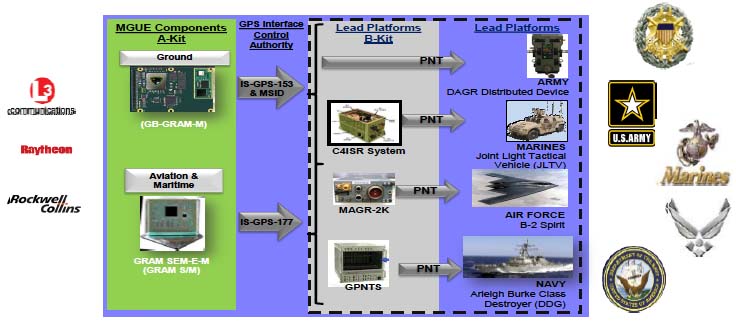
Senate lawmakers made clear their ire with the GPS program, recommending funding cuts for nearly every element and slashing development monies for the troubled new ground control system before taking off for the Memorial Day holiday.
Senate lawmakers made clear their ire with the GPS program, recommending funding cuts for nearly every element and slashing development monies for the troubled new ground control system before taking off for the Memorial Day holiday.
The Senate Appropriations Committee approved a total defense spending package of $568 billion for fiscal year 2017, giving the Pentagon a $1.5 billion dollar boost over its 2016 allotment. Within that package, however, were cuts to nearly every GPS-related program, including a $260 million hollowing out of the administration’s $393-million request for the Next Generation Operational Control System or OCX.
Ground Shifts Under OCX
The OCX ground system incorporates advanced cybersecurity protections and is essential to using all the capabilities built into the upcoming GPS III satellites. Those satellites are to offer signal-boosting spot beams to power through jamming and add to the total number of spacecraft broadcasting the encrypted M-code.
M-code improves a receiver’s ability to get an initial lock and operate near Blue Force (friendly) jammers, according to an April 2015 briefing from the Air Force’s Space and Missile Systems Center. M-code receivers also will be able to better detect and reject spoofed signals and can have their encryption keys changed more easily.
Raytheon, the OCX prime contractor, is working on OCX Block 0 and is expected to deliver it next fall. Raytheon must deliver Block 1 in order for the Air Force to be able to integrate GPS III into the existing constellation and achieve full operational capability, according to the Government Accountability Office (GAO). OCX Block 2 will expand that capability.
The program, however, is years behind schedule and costs could reach $5.3 billion. When the contract was awarded in 2010, it was valued at slightly more than $1.5 billion including options.
In the fiscal year 2017 budget request the Air Force estimated the total cost of the program at $4.82 billion of which $3.70 billion would be needed to complete the Phase B OCX Block 1 and 2 development. That budget placeholder number is still being reworked to reflect a two-year extension in the development timeline approved in December.
Despite the problems Gen. John Hyten, the commander of Air Force Space Command said that OCX remains the service’s best option.
"As we sit here today," he told House lawmakers in March, "the best answer is for Raytheon, the contractor involved, to deliver that capability in a time-certain manner and give us the capability that we need to make sure that GPS is available for future years and in a cyber secure environment."
During that same hearing before House Subcommittee on Strategic Forces, Dyke Weatherington, the acting deputy assistant secretary of defense for space, strategic, and intelligence systems, said the Department of Defense (DoD) believed Raytheon could deliver.
As a stopgap measure, the Air Force awarded a $96 million contract awarded to Lockheed Martin last December to modify the current GPS operational control segment (OCS) to operate all GPS III satellites that are launched prior to the transition to OCX.
OCX Termination Recommended
But Senate lawmakers are not buying it.
Noting that both the contactor and the Air Force told the GAO that a "more than 4-year additional delay was likely necessary," Senate budgeters concluded "the feasibility of meeting a new 2-year schedule remains in question."
"The Committee is concerned that the program cannot correct course and meet the new schedule," they wrote in the report accompanying the 2017 Department of Defense Appropriations Act (S. 3000). "Further delays and problems in the OCX program will only delay the operation of GPS III replenishment satellites and risk national security. The Committee believes the Air Force should work with the contractor to ensure that OCX Block 0, which will enable launch and checkout of GPS III satellites, is completed, and turn its focus toward ensuring that the interim OCS solution succeeds, on schedule and on budget."
In short, if the full Senate approves the measure passed by the committee — and the House concurs — the appropriations bill would terminate OCX Block 1 and 2.
The committee’s decision echoes that of the Senate Armed Services Committee, which passed a defense authorization bill earlier in May withholding all monies for the OCX program until the secretary of defense makes a Nunn-McCurdy certification. That certification must state that OCX is essential to the national security, is more important than other programs that will have to be cut to accommodate cost overruns, and that there are no acceptable alternatives.
The Alternative
To secure the benefits of M-code without Blocks 1 and 2 the committee added back in $30 million in ground system money but earmarked it "for enhancements to the OCS ground system that will enable M–code broadcast capabilities and ensure that our warfighters have this necessary capability in the most timely manner possible."
This builds on the $96-million Lockheed contract. Interestingly, Lockheed announced in November that it had upgraded the security elements in OCS to "to safeguard data and ensure satellite availability."
"The GPS Intrusion Protection Reinforcement (GIPR) technology refresh is part of the Air Force’s strategy to modernize the current GPS system and to ensure the availability of its services," the company said in a November 7 press release.
The GIPR contract, which was awarded in 2013, also resolves many equipment obsolescence issues and increases system maintainability with modern vendor-supported hardware and operating systems, Lockheed said. Security, obsolescence, and maintainability were at the heart of why the Air Force wanted OCX in the first place.
Other Senate Cuts
Where House appropriators recommended full funding for GPS programs across the board, including OCX, the Senate decided to trim nearly everything.
House appropriators approved $142 for GPS III Research Testing Development and Evaluation (RTD&E) and $278 million for military GPS user equipment (MGUE).
Senate lawmakers justified their $25 million cut to MGUE as “restoring acquisition accountability" in the face of "unjustified cost growth." They also shaved $7.5 million off the request for RTD&E money saying it was to "reduce duplication: funding enterprise and unique ground system."
Senate and House appropriators did agree on two recommendations. They both fully supported the administration’s request for $34 million to fund procurement for the GPS III program and they zeroed out a $3-million request for the GPS IIF program, calling it “unjustified"
Launch Money Cut
The GPS program has already contracted for eight GPS III satellites and is expected to sign contracts soon for two more. A deal to build the rest of as many as 22 spacecraft is now up for grabs. The Air Force announced May 5 that it was awarding Boeing, Lockheed Martin, and Northrop Grumman $5 million each to demonstrate that they can build the next tranche of spacecraft.
Exactly when all these spacecraft will be launched, however, is anyone’s guess. Not only has the GPS III program suffered technical delays, but now its launch funding may be cut. The Senate bill would deny $295 million for two launches as being “ahead of need" and another $200 million for launch infrastructure.
Given that even the backup ground control system may not be ready in time for some of the planned GPS III launches, the lawmakers determined that the two GPS III launches planned for 2017 were "ahead of need." The $200 million they cut was for the launch capability for those two launches and another two flights that were supposed to take place this fiscal year but will not — one because of a scheduling change and the other because it was terminated by Congress.
The schedules for the backup GPS ground system and the launches just don’t line up, lawmakers said.
"The 2017 budget request outlines a plan to launch six satellites before 2019, the earliest the Air Force expects to have a Contingency Operations [COps] solution that would enable operation of the GPS III satellites in the constellation," they wrote in the report. "The Committee sees no justification for launching so many satellites without a system in place to operate them."




